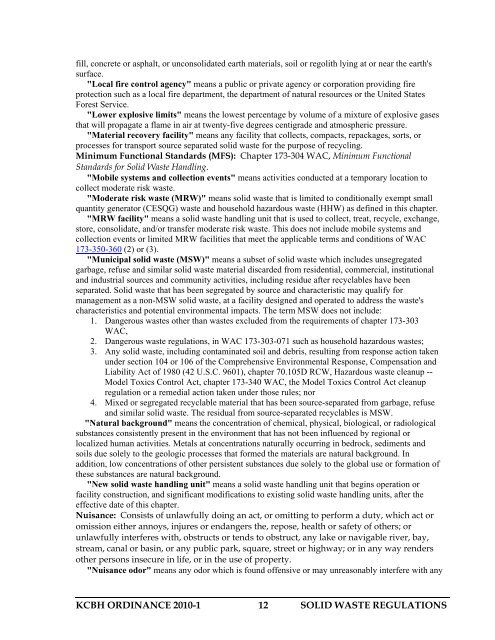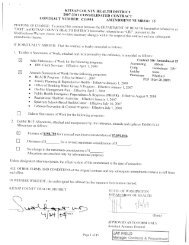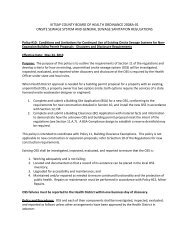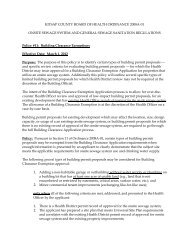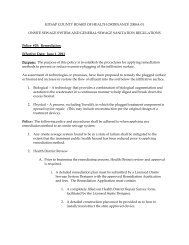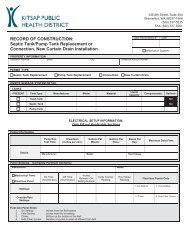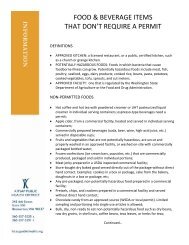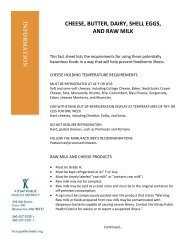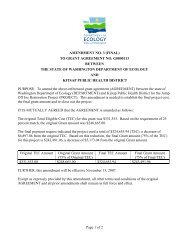SOLID WASTE REGULATIONS - Kitsap Public Health District
SOLID WASTE REGULATIONS - Kitsap Public Health District
SOLID WASTE REGULATIONS - Kitsap Public Health District
You also want an ePaper? Increase the reach of your titles
YUMPU automatically turns print PDFs into web optimized ePapers that Google loves.
fill, concrete or asphalt, or unconsolidated earth materials, soil or regolith lying at or near the earth's<br />
surface.<br />
"Local fire control agency" means a public or private agency or corporation providing fire<br />
protection such as a local fire department, the department of natural resources or the United States<br />
Forest Service.<br />
"Lower explosive limits" means the lowest percentage by volume of a mixture of explosive gases<br />
that will propagate a flame in air at twenty-five degrees centigrade and atmospheric pressure.<br />
"Material recovery facility" means any facility that collects, compacts, repackages, sorts, or<br />
processes for transport source separated solid waste for the purpose of recycling.<br />
Minimum Functional Standards (MFS): Chapter 173-304 WAC, Minimum Functional<br />
Standards for Solid Waste Handling.<br />
"Mobile systems and collection events" means activities conducted at a temporary location to<br />
collect moderate risk waste.<br />
"Moderate risk waste (MRW)" means solid waste that is limited to conditionally exempt small<br />
quantity generator (CESQG) waste and household hazardous waste (HHW) as defined in this chapter.<br />
"MRW facility" means a solid waste handling unit that is used to collect, treat, recycle, exchange,<br />
store, consolidate, and/or transfer moderate risk waste. This does not include mobile systems and<br />
collection events or limited MRW facilities that meet the applicable terms and conditions of WAC<br />
173-350-360 (2) or (3).<br />
"Municipal solid waste (MSW)" means a subset of solid waste which includes unsegregated<br />
garbage, refuse and similar solid waste material discarded from residential, commercial, institutional<br />
and industrial sources and community activities, including residue after recyclables have been<br />
separated. Solid waste that has been segregated by source and characteristic may qualify for<br />
management as a non-MSW solid waste, at a facility designed and operated to address the waste's<br />
characteristics and potential environmental impacts. The term MSW does not include:<br />
1. Dangerous wastes other than wastes excluded from the requirements of chapter 173-303<br />
WAC,<br />
2. Dangerous waste regulations, in WAC 173-303-071 such as household hazardous wastes;<br />
3. Any solid waste, including contaminated soil and debris, resulting from response action taken<br />
under section 104 or 106 of the Comprehensive Environmental Response, Compensation and<br />
Liability Act of 1980 (42 U.S.C. 9601), chapter 70.105D RCW, Hazardous waste cleanup --<br />
Model Toxics Control Act, chapter 173-340 WAC, the Model Toxics Control Act cleanup<br />
regulation or a remedial action taken under those rules; nor<br />
4. Mixed or segregated recyclable material that has been source-separated from garbage, refuse<br />
and similar solid waste. The residual from source-separated recyclables is MSW.<br />
"Natural background" means the concentration of chemical, physical, biological, or radiological<br />
substances consistently present in the environment that has not been influenced by regional or<br />
localized human activities. Metals at concentrations naturally occurring in bedrock, sediments and<br />
soils due solely to the geologic processes that formed the materials are natural background. In<br />
addition, low concentrations of other persistent substances due solely to the global use or formation of<br />
these substances are natural background.<br />
"New solid waste handling unit" means a solid waste handling unit that begins operation or<br />
facility construction, and significant modifications to existing solid waste handling units, after the<br />
effective date of this chapter.<br />
Nuisance: Consists of unlawfully doing an act, or omitting to perform a duty, which act or<br />
omission either annoys, injures or endangers the, repose, health or safety of others; or<br />
unlawfully interferes with, obstructs or tends to obstruct, any lake or navigable river, bay,<br />
stream, canal or basin, or any public park, square, street or highway; or in any way renders<br />
other persons insecure in life, or in the use of property.<br />
"Nuisance odor" means any odor which is found offensive or may unreasonably interfere with any<br />
KCBH ORDINANCE 2010-1 12 <strong>SOLID</strong> <strong>WASTE</strong> <strong>REGULATIONS</strong>


